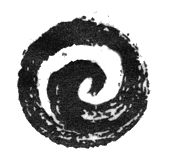The following interview with Tim Cartmell was taken from the Wu Gong Journal, May-June 1998,vol. 3, #15.
You started training in martial arts very young. What led you to move to Taiwan for further study?
I started practicing Kung Fu San Soo when I was eleven years old. I studied for twelve years until I moved to Taiwan in 1984. Through
reading I became interested in the so-called Internal martial arts. I had already practiced what was considered to be an
External art for quite a period of time. Although I was young and had much to learn, I realized there was a limit to how strong and
fast one could become, and that those attributes would decline with age. San Soo is a non-sportive, purely fighting oriented martial art.
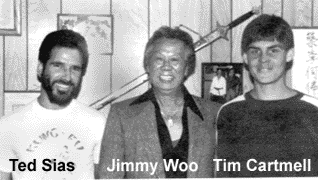
I was always looking for other methods of training and technique that would increase my martial ability. When I read about the Internal
arts, I was intrigued by their philosophy and the idea of the soft overcoming the hard. The ideas made sense to me, although at the time
I really couldn't imagine how it all worked. As I looked around, I failed to find what I was looking for. Although I
met a couple teachers who practiced the Internal arts along with their External Arts, and who were quite good, it still
wasn't what I was looking for. The Tai Ji Quan that I saw being practiced was useless for fighting, and the majority of the other Internal styles
I saw were not being practiced as they were preached. That is not to say there were no competent instructors of the Internal around,
I just didn't find any. So, I decided to "go to the source" and look for teachers in China.
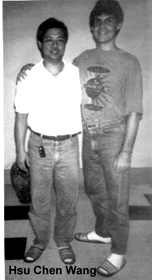 |
As a westerner, what kind of difficulties did you face in trying to study Chinese martial arts and adapt to what must have been a very different cultural lifestyle? I didn 't know anyone in Taiwan when I went, and I couldn' t yet speak Chinese. I applied to the Chinese language program at the Taiwan Normal University where I would study for five years. I had a letter of introduction to one teacher and immediately began to look around and make connections in the martial arts community. I made friends with other martial artists and went to see every teacher I could. The situation in Taiwan and Mainland China is the same as anywhere else, for every outstanding teacher there are legions of mediocre ones. I had a very specific agenda for study. Although I didn't understand the Internal martial arts at the time, I did understand fighting, and I was looking for practicality. In retrospect, I was very fortunate in meeting and being accepted by several outstanding teachers. Over the years, I had several false starts with teachers who took my money but held back instruction, but all in all, the vast majority of teachers I met and trained with were open and generous in their instruction. As far as adapting to the culture, I found it a little difficult at first, but I loved Asia from the start and soon felt quite at home; so much so that I stayed in China and studied for eleven years. |
|
A great variety of Chinese martial arts styles are taught in Taiwan. What was your reason for concentrating on the internal styles?
Although there were many fine martial artists of various styles in Taiwan, and I did study some of the External styles, I was determined
to see if the stories I had read and heard about the practice of the Internal styles were true.
Fortunately, I met and trained for years with teachers of exceptional ability, men whose
skills exceeded all my expectations. To clarify, I wasn't looking for (nor have I ever seen) anyone with "mysterious powers,"
pushing people without physical contact, the "death touch" or other such nonsense.
I was looking for practical martial ability of a higher order.
Basically, I was looking for methods that were not based solely on brute strength, speed and superior
size; I was looking for arts in which the soft could really overcome the hard.
|
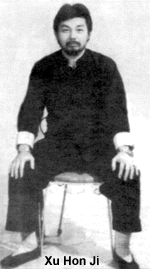 |
|
What do you consider to be the distinguishing characteristics of Tai Ji, Xing Yi and Ba Gua, beyond the obvious physical differences? In answer to this question, let me first state that after twenty-five years of martial arts study and practice I think the labels Internal and External, although convenient, are really misnomers. In fact, if you ask a hundred different practitioners of the Chinese arts for a definition of these terms, you'll probably get a hundred different answers. In my opinion, all martial arts are based on certain sets of principles. The principles define the style. Calling Xing Yi Quan, Tai Ji Quan and Ba Gua Zhang Jnternal arts only began about seventy years ago. This came about because some famous practitioners of these styles in the early part of the Twentieth Century (most notably Sun Lu Tang) cross trained, and subsequently began referring to these arts as belonging to the same family, as they were based upon similar principles. Prior to this time, Xing Yi Quan, Tai Ji Quan, Ba Gua Zhang, the Shaolin arts, Long Fist, etc. were simply categorized as martial arts. What the above mentioned masters were referring to when they chose the label Internal was the underlying principles which were common to the arts they studied. Principles of the arts later named Internal were complete physical relaxation, yielding to force, the use of the power of the whole body under mental control and relying on sensitivity and skill to overcome brute strength. Now here is the problem with such labels. It is not the particular Art itself that is Internal or External, it is the way the art is practiced. There are no Internal or External martial arts, only Internal and External practitioners (if we assume Internal refers to the principles listed above, and external is anything which is outside of these principles). I have seen practitioners of the so-called External arts who were as soft as cotton and who threw their opponents seemingly by magic. I have also seen practitioners of Xing Yi Quan tensing their muscles so much that their arms were shaking with the effort. I often hear other teachers refer to some style as being Internal while another is External out of hand; if questioned, they really have no clear concept of the difference. It is popular to repeat some nebulous definition along the lines of the Internal styles cultivating Qi while the External styles are more concerned with muscle force. This is merely parroting the party line and, I think it will only lead to increasing confusion. Arts of Xing Yi Quan, Tai Ji Quan and Ba Gua Zhang, as Internal styles (based upon the principles of relaxation, yielding and skill listed above) really only differ in the manner in which these principles are applied, due to their founders' personal backgrounds, temperaments and needs. In a nutshell, Xing Yi Quan techniques tend to be more percussive in nature, with the Xing Yi Quan fighter preferring to attack, otherwise taking the smallest defensive angle possible before counter-attacking. It is important to remember Xing Yi Quan is an art originally based upon spear fighting. Tai Ji -Quan techniques tend toward yielding to force completely and then returning it to the opponent, much as the rebound of a rubber ball or the counter action to pressure on a balance scale. Tai Ji Quan techniques have their roots in the hand to hand combat techniques of the unarmed warrior dealing with an armed opponent. Ba Gua Zhang techniques differ widely between styles but emphasize mobility, flexible bodywork and evasion with direct counter attack. Striking combinations are secondary to throwing, takedown and leverage techniques. |
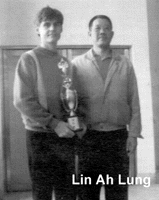 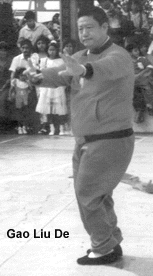
|
Do you favor one internal system over the others, and if so, why?
Since the Internal systems are based upon the same principles, training in one will develop the attributes necessary in the others. I think the important point is that no single martial art is adequate to prepare the practitioner for the full range of situations that may potentially occur in a real fight. Individuals will naturally gravitate toward those arts which best suit their individual physicality and personality, but it is vital to become well rounded enough to have constructive responses to any situation which may arise. Almost without exception, all of the famous masters of old (those that were famous for actually fighting) trained in several different systems. Cross training was and is the only way to truly prepare for real fighting. Remember that all styles of martial arts were founded by men who had cross-trained, and then christened their synthesis as a new style. As much as the romantic in us would like to believe the old myths, the truth is no one ever learned a style in a dream, from reading the Book of Changes or from watching snakes, birds and bugs. Personally, I believe that for the vast majority of people, although it is vital to be able to punch and kick, a foundation in the wrestling/grappling-based arts is the most important for martial proficiency.
What are your personal feelings about the internal and external styles?
I think I summed up my feelings about the internal and external styles above. I would only add that I believe it is important to respect the practitioners of all types of martial arts, regardless of the style. Remaining humble with an open mind is the only way to continuous improvement. You can learn something from just about everyone. I often tell my students, "if it works for you, it's good."
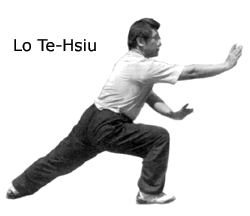
When did you first visit Mainland China,and did you gain access to any teachers there?
I first went to mainland China in 1985. I traveled extensively and went to see some of the well-known centers of martial arts, like the Shaolin Temple. But besides a few push hands sessions and some light sparring with various practitioners that I met, I didn't pursue any serious study. At that time, there was far less personal freedom than there has been in more recent times. It was several years later, when I accompanied Dan Miller (who was then publishing the Ba Gua Journal) as his interpreter that I met a great number of well known martial artists, and made many valuable connections.
Were you able to learn some methods that were not available to you in Taiwan?
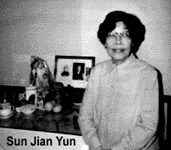
In Beijing, I studied Sun Style Tai JI Quan and Ba Gua Zhang with the Sun family. There is, to my knowledge, no one practicing or teaching Sun style martial arts in Taiwan. Most of the Xing Yi Quan taught in Taiwan is He Bei style, and my Xing Yi Quan teachers in Taiwan were all He Bei stylists. I had the valuable opportunity to study Shan Xi style in the mainland.
You learned both Hebei and Shanxi style Xing Yi. How do these two schools differ from each other?
Both He Bei and Shan Xi styles are Five Element based systems of Xing Yi Quan and originate from the same source. Shan Xi style is characteristically softer than He Bei style, and is perhaps closer to the original Art. He Bei style was influenced considerably by the other martial arts of He Bei province. He Bei is the home of many formidable martial arts styles. The sequence of training is also somewhat different between these two styles. The majority of He Bei stylists are first taught to practice the forms with what is known as Ming Jing, or obvious energv. The use of some overt force is encouraged. Later, as the student masters the movement they become softer in appearance and progressively more relaxed. On the contrary, Shan Xi style training begins by practicing the forms in an absolutely relaxed manner; the movements are done slowly, smoothly and without force. The goal is to cultivate correct body mechanics and an acute sensitivity to balance and momentum. Later, speed is added while the underlying relaxation is maintained. In application, He Bei style favors more percussive techniques while Shan Xi style includes more projections and Chin Na (leverage) techniques.
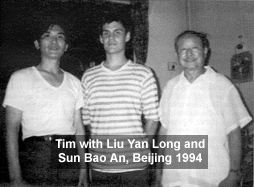
You competed in some full contact tournaments in Taiwan. What did you learn from this experience?
After I had been training in Taiwan about six months, my Xing Yi Quan teacher entered me in a full contact tournament. Though I lost, it was an enlightening experience for me. Although there were few rules in these matches, there was a certain strategy that applied, much different from a street fight for example. Many of the Chinese fighters are extremely tough, and they usuallv dominate the international competitions there. Competing with them I gained valuable experience and insight into my own methods of training. I went back to revise my training based on my experiences and, a few months later, I entered another full contact competition. The organizers put me up into the light heavyweight division although at the time I was only 150 lbs. I took first place in the division and came through without injury. This experience was very valuable as it indicated my training methods were on the right track. The next year I entered one of the larger international tournaments. I won again, taking first place in the middleweight division. I feel these competitions gave me a wealth of valuable experience. I think the most important lessons I learned from these fights was that you can never practice the basics too much. You need to be a well rounded fighter, but knowing a thousand techniques you can do beautifully when there is no real pressure is not nearly as valuable as mastering a few techniques you can actually use in a real fight. It is, however, vital to be exposed to all areas of fighting. In order to be able to maintain mental calm and physical relaxation under pressure, you must be proficient in striking, wrestling and grappling arts. Sparring with skilled, non-cooperative opponents is a must if you hope to be able to use your art in a real fight. Finally, your mind-set and attitude will almost always prove to be the ultimate determinate of your victory or defeat.
There is a lot of talk about the martial arts of mainland China focusing too much on the sport and health aspect. Did you find this to be true?
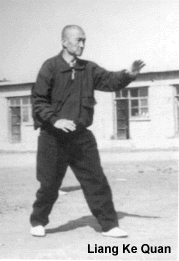
The mainland government focuses most all of its support on performance Wu Shu. Traditional martial arts are all but neglected. Fortunately, the trend in recent years has been toward more tolerance and acceptance by the powers that be for the traditional and combat oriented styles. Whereas not too many years ago teachers of the traditional arts had to teach in secrecy, they are now able to teach in the open and even travel abroad to teach. Also, the recent proliferation of San Shou full contact tournaments is, I think, an important development is the preservation of true martial arts. Modern Wu Shu is a fine sport and is beautiful to watch, but it is misnamed; arts without fighting cannot by definition be considered martial arts.
How did training in Taiwan, Mainland China and the U.S. differ?
There are very few commercial martial arts schools in Taiwan and almost none in the Mainland (government run Wu Shu schools excepted). Teachers in China rarely teach martial arts as a career. Most instruction takes place in the early Morning or evening after work. Most teachers conduct classes in parks or their homes. Tuition can be expensive however. Many of the more well known and competent teachers will charge a fair amount for instruction, and very often foreigners will pay more than Chinese students. Often times being accepted by a teacher is not easy, there may be a period of time during which the students will be expected to prove their sincerity to learn. Training in the combat oriented styles also may tend to be somewhat rougher than in many schools in the States. Although the student is naturally expected to respect the teacher, contrary to what many foreigners believe, training in China is usually done in an informal atmosphere; there is little bowing, kowtowing, or calling the teacher "Shifu" or other such titles. This seems to be mainly an American phenomenon.
Can you give a chronology of your different Chinese martial arts teachers and the methods you studied with them?
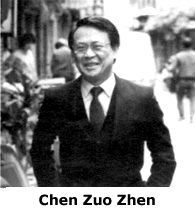
I began training in Kung Fu San Soo with Ted Sias and later continued training with Jimmy H. Woo. In Taiwan, I studied Xing Yi Quan with
Xu Hong Ji and later with his son Xu Zhen Wang. I studied Old style Yang Tai Ji Quan and Xu Xi Dao (an esoteric Crane style) with Chen
Zhuo Zhen. My next Tai Ji Quan teacher was Lin Ah Long, who taught me the Yang and Chen Zhao Bao styles. I studied Yi Quan and the Internal
styles with Gao Liu De. I studied the Old Frame of the Chen style with Xu Fu Jin. I studied Gao style Ba Gua Zhang and Chen Pan Ling
style Tai Ji Quan with Luo De Xiu. In mainland China, I studied He Bei style Xing Yi Quan with
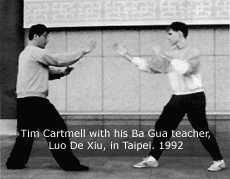 Liang Ke Quan. I studied Sun style Ba Gua Zhang and Tai Ji Quan with Sun Jian Yun, Sun Bao An and Liu Yan Long.
I studied Shan Xi Xing Yi with Mao Ming Chun.
Liang Ke Quan. I studied Sun style Ba Gua Zhang and Tai Ji Quan with Sun Jian Yun, Sun Bao An and Liu Yan Long.
I studied Shan Xi Xing Yi with Mao Ming Chun.
What is in store for Tim Cartmell in the future?
I plan to continue training, studying, teaching in my school and doing seminars around the country. I have published several instructional books and videotapes and have several projects planned for the future. Besides my own material I am looking for quality martial arts books to translate from the Chinese. I have also been practicing Brazilian Jiu Jitsu since I returned to the States in 1994, and plan to continue training and competing.
Shen Wu Academy of Martial Arts
7411 Garden Grove Blvd. Suite F
Garden Grove CA
92841
(714) 890-0605
shenwu@verizon.net
![]()
Biography
|
Philosophy
|
Ba Gua Zhang
|
Xing Yi Quan
|
Tai Ji Quan
Tru Balance
|
Books & Videos
|
Links
|
Classes& Seminars

